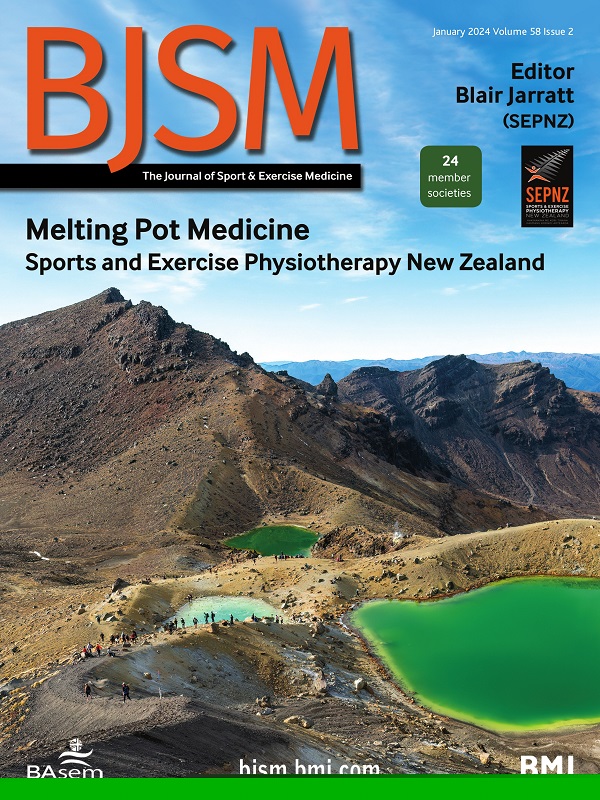From margins to mainstream: sixty years of sports medicine in the Netherlands
IF 16.2
1区 医学
Q1 SPORT SCIENCES
引用次数: 0
Abstract
In 2025, the Netherlands celebrates 60 years of organised sports medicine. What began as peripheral support for athletes has evolved into a formally recognised medical specialty with academic and clinical depth. National full recognition as a clinical specialty in 2014 and European recognition in 2024 by the Union Européenne des Médecins Spécialistes (UEMS) mark key milestones. This editorial reflects on the Dutch journey, its impact on research and practice and compares it with other emerging specialties. BJSM itself has chronicled this evolution, including a 1988 reflection on the growing scholarly relevance of sports medicine.1 Dutch sports medicine emerged in the 1960s, driven by a growing culture of physical activity and competitive sport. The early focus was practical: preventing injuries, overseeing training and ensuring safe participation. Dutch pioneers soon integrated exercise physiology and clinical medicine, laying the groundwork for the discipline’s dual role in performance and public health. A key step was the founding of the Netherlands Association of Sports Medicine (VSG) in 1965, which formalised a professional identity and linked clinical practice, education and pioneering research. Notably, the Netherlands had already contributed to laying the foundations of international sports medicine: during the 1928 Olympic Games in Amsterdam, the first international sports medicine congress was held, laying the groundwork for future collaboration and the eventual founding of Fédération Internationale de Médecine du Sport (FIMS) in 1933. In 1975, the Dutch Heart Foundation …从边缘到主流:荷兰运动医学六十年
2025年,荷兰庆祝有组织的运动医学成立60周年。最初作为运动员的外围支持已经发展成为具有学术和临床深度的正式认可的医学专业。2014年被国家全面认可为临床专业,2024年被欧盟(UEMS)认可为欧洲认可,这是重要的里程碑。这篇社论反映了荷兰的旅程,它对研究和实践的影响,并将其与其他新兴专业进行了比较。BJSM本身记录了这一演变,包括1988年对运动医学日益增长的学术相关性的反思荷兰运动医学兴起于20世纪60年代,受日益增长的体育活动和竞技体育文化的推动。早期的重点是实用的:防止受伤,监督训练和确保安全参与。荷兰的先驱们很快将运动生理学和临床医学结合起来,为这门学科在表演和公共卫生方面的双重作用奠定了基础。关键的一步是1965年荷兰运动医学协会(VSG)的成立,它正式确立了一个专业身份,并将临床实践、教育和开创性研究联系起来。值得注意的是,荷兰已经为奠定国际运动医学的基础作出了贡献:在1928年阿姆斯特丹奥运会期间,举行了第一届国际运动医学大会,为今后的合作奠定了基础,并最终于1933年成立了国际体育运动协会(FIMS)。1975年,荷兰心脏基金会…
本文章由计算机程序翻译,如有差异,请以英文原文为准。
求助全文
约1分钟内获得全文
求助全文
来源期刊
CiteScore
27.10
自引率
4.90%
发文量
217
审稿时长
3-8 weeks
期刊介绍:
The British Journal of Sports Medicine (BJSM) is a dynamic platform that presents groundbreaking research, thought-provoking reviews, and meaningful discussions on sport and exercise medicine. Our focus encompasses various clinically-relevant aspects such as physiotherapy, physical therapy, and rehabilitation. With an aim to foster innovation, education, and knowledge translation, we strive to bridge the gap between research and practical implementation in the field. Our multi-media approach, including web, print, video, and audio resources, along with our active presence on social media, connects a global community of healthcare professionals dedicated to treating active individuals.

 求助内容:
求助内容: 应助结果提醒方式:
应助结果提醒方式:


